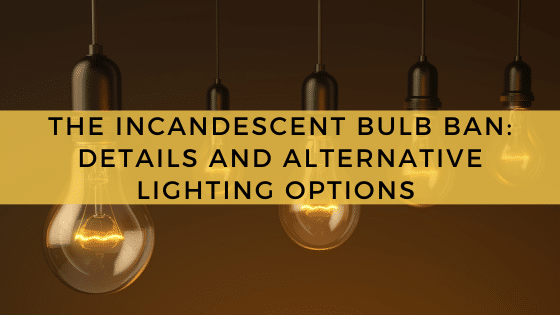
On August 1, 2023, an impactful piece of lighting regulation went into effect. The Energy Independence and Security Act, more than 15 years in the making, finally became official at the start of the month and has put new efficiency standards in place.
The most notable is the minimum required lumen-to-watt ratio for newly manufactured lights. All new bulbs must output at least 45 lumens per watt, a threshold that incandescent bulbs cannot meet. The result is a de facto ban that will take most, but not all, incandescent bulbs off the market.
Let’s address the ban’s details and what consumers can do to adapt in response.
How Will the Incandescent Ban Affect Consumers and Manufacturers?
Multiple lighting regulations have been passed in recent years, and they follow the same pattern as the incandescent ban. Technically, it’s not a ban, because consumers are permitted to use their existing incandescent bulbs (and any they can find to purchase) until they no longer work.
The ban’s teeth are really felt on the manufacturing side because new incandescent bulbs cannot be made as none are capable of meeting the 45-lumen minimum.
Manufacturers have steadily been pulling their incandescent products, but this trend will likely accelerate until they are impossible to buy anywhere. At that point, alternative lighting solutions will be needed.
Which Incandescent Light Bulbs are Getting Banned?
Although most incandescent lights are included in the manufacturer ban, there are a handful of exceptions. They include:
- Appliance lamps, such as oven lights
- Black lights
- Bug lamps
- Colored lamps
- Infrared lamps
- Left-handed thread lamps
- Plant lights
- Flood lights
- Reflector lamps
- Showcase lamps
- Traffic signals
- A small number of other specialty lamps, like marine lights
These lights do not need to meet a minimum lumen requirement to be manufactured, sold, or utilized.
What is the Reasoning Behind the Incandescent Bulb Ban?
The Energy Independence and Security Act was originally conceived as a bipartisan piece of legislation, proposed by the Bush administration. Then, like now, the act was intended to improve energy efficiency among U.S.-based lighting solutions. The hope is that improved energy efficiency will save consumers $3 billion or more in utility bills. Also, the hope is that the new regulations will reduce carbon emissions by hundreds of metric tons every year.
Incandescent bulbs are being targeted because they are the least energy efficient lighting technology on the market. As a piece of early 19th-century engineering, that’s not a surprise. The problem is the metal filament, which is heated to more than 2,000 degrees Celsius to produce light. About 90 percent of the energy injected into an incandescent bulb is wasted on heat, so only a small portion is used to produce illumination – the definition of inefficient lighting.
LED Lights are an Effective Alternative to Incandescent Bulbs
With the ban in place, it’s likely that consumers will gravitate to high-efficiency options in order to stay ahead of future regulations.
LED bulbs are poised to be that high-efficiency option for the vast majority of applications. LED light bulbs output close to 100 lumens per watt, so they exceed the required minimum with plenty of room to spare.
Of course, LED lighting isn’t a new technology for most people. It’s already in use in residential and commercial properties throughout the country. In fact, the Energy Information Administration (EIA) found that about half of commercial buildings were already running LED lighting back in 2018. That number is likely much higher today.
LED Retrofits Make Switching from Incandescent Bulbs Easy
LED lighting has improved greatly in recent decades. Some of the initial pushback against LED lighting technology was based on perceived quality issues like undesirable color temperatures and flickering. Those issues were always minor and fixable, and now they have been addressed. Today’s LED bulbs can generate a wide spectrum of color temperatures, including warmer tones that incandescent lamps are known for. Further, LED lights generate illumination that’s superior in brilliance, quality, and spectral range to other mainstream lighting options, like HIDs and fluorescents. LED systems are more efficient than all other major lighting technologies.
The only remaining issue for many businesses is the initial costs associated with purchasing LED lighting, but the cost of LED lighting has declined rapidly, especially when tax incentives, rebates, and retrofit solutions are factored in.
LED retrofits are an emerging solution for companies that need to boost their lighting efficiency but don’t have the capital to invest in an entirely new system.
During an LED retrofit, the existing lighting fixtures are preserved, along with most of the underlying electrical infrastructure. In some cases, ballasts may need to be replaced with LED drivers, but there are some retrofit LED lamps that can also function with traditional ballasts.
Because only the bare minimum is replaced – often just the bulbs – companies can easily minimize their upfront costs while still attaining the energy efficiency, longevity and performance advantages associated with LED lighting technology.
Work With an Experienced LED Lighting Expert for Solutions to the Incandescent Bulb Ban
While many companies have already moved on from incandescent bulbs, nearly 20 percent of commercial facilities still relied on this outdated form of illumination in 2018. If your facility is among them, it’s time to formulate a lighting transition plan. Incandescent lighting supplies will continue to become more scarce over time. Again, this is a pattern seen with other lights that have come under recent regulatory scrutiny – such as T-12 fluorescents.
However, this is a switch that many businesses are eagerly welcoming. That’s because LEDs aren’t just future-proofed against future regulations – they’re also inexpensive to operate and maintain, while providing excellent lighting performance.






